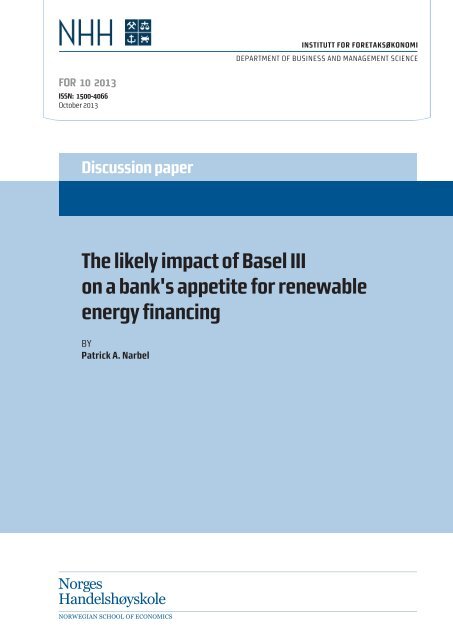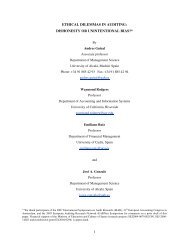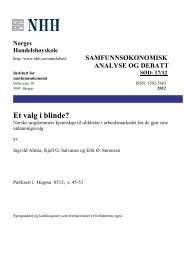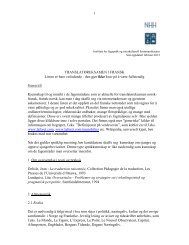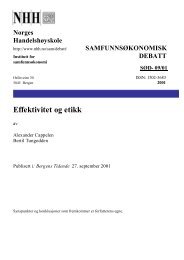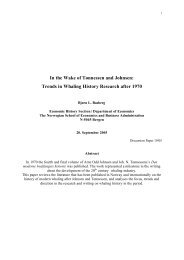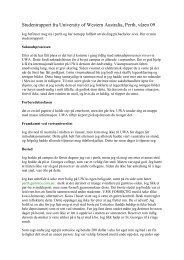The likely impact of Basel III on a bank's appetite for ... - NHH
The likely impact of Basel III on a bank's appetite for ... - NHH
The likely impact of Basel III on a bank's appetite for ... - NHH
Create successful ePaper yourself
Turn your PDF publications into a flip-book with our unique Google optimized e-Paper software.
INSTITUTT FOR FORETAKSØKONOMIDEPARTMENT OF BUSINESS AND MANAGEMENT SCIENCEFOR 10 2013ISSN: 1500-4066October 2013Discussi<strong>on</strong> paper<str<strong>on</strong>g>The</str<strong>on</strong>g> <str<strong>on</strong>g>likely</str<strong>on</strong>g> <str<strong>on</strong>g>impact</str<strong>on</strong>g> <str<strong>on</strong>g>of</str<strong>on</strong>g> <str<strong>on</strong>g>Basel</str<strong>on</strong>g> <str<strong>on</strong>g>III</str<strong>on</strong>g><strong>on</strong> a <strong>bank's</strong> <strong>appetite</strong> <strong>for</strong> renewableenergy financingBYPatrick A. Narbel
<str<strong>on</strong>g>The</str<strong>on</strong>g> <str<strong>on</strong>g>likely</str<strong>on</strong>g> <str<strong>on</strong>g>impact</str<strong>on</strong>g> <str<strong>on</strong>g>of</str<strong>on</strong>g> <str<strong>on</strong>g>Basel</str<strong>on</strong>g> <str<strong>on</strong>g>III</str<strong>on</strong>g> <strong>on</strong> a bank’s <strong>appetite</strong> <strong>for</strong> renewableenergy financing.Patrick A. Narbel aa Department <str<strong>on</strong>g>of</str<strong>on</strong>g> Business and Management Science, Norwegian School <str<strong>on</strong>g>of</str<strong>on</strong>g> Ec<strong>on</strong>omics, Bergen, NorwayAbstract<str<strong>on</strong>g>The</str<strong>on</strong>g> new <str<strong>on</strong>g>Basel</str<strong>on</strong>g> <str<strong>on</strong>g>III</str<strong>on</strong>g> regulati<strong>on</strong>s are <str<strong>on</strong>g>likely</str<strong>on</strong>g> to make l<strong>on</strong>g-term financing more expensive, whichwill affect the financing <str<strong>on</strong>g>of</str<strong>on</strong>g> capital-intensive renewable energy technologies, because theytypically rely <strong>on</strong> l<strong>on</strong>g-term financing. In additi<strong>on</strong>, the capital and liquidity requirements <str<strong>on</strong>g>of</str<strong>on</strong>g><str<strong>on</strong>g>Basel</str<strong>on</strong>g> <str<strong>on</strong>g>III</str<strong>on</strong>g> are <str<strong>on</strong>g>likely</str<strong>on</strong>g> to limit the amount <str<strong>on</strong>g>of</str<strong>on</strong>g> capital available <strong>for</strong> renewable energy financingfrom banks in the future. Together, these are threats to renewable energy deploymentbecause limited financing may prevent the financing <str<strong>on</strong>g>of</str<strong>on</strong>g> some projects and because moreexpensive loans are <str<strong>on</strong>g>likely</str<strong>on</strong>g> to make a number <str<strong>on</strong>g>of</str<strong>on</strong>g> projects uninteresting financially. A potentialsoluti<strong>on</strong> is proposed here, which requires financing capital-intensive energy projects, poolingthese investments into a portfolio and selling down the portfolio in tranches to various types<str<strong>on</strong>g>of</str<strong>on</strong>g> investors. <str<strong>on</strong>g>The</str<strong>on</strong>g> benefit <str<strong>on</strong>g>of</str<strong>on</strong>g> this soluti<strong>on</strong> <strong>for</strong> banks is that it will allow them to maintain thefinancing <str<strong>on</strong>g>of</str<strong>on</strong>g> capital intensive renewable energy projects, while complying more easily with<str<strong>on</strong>g>Basel</str<strong>on</strong>g> <str<strong>on</strong>g>III</str<strong>on</strong>g>.1. Introducti<strong>on</strong>In resp<strong>on</strong>se to the 2007 financial crisis, a new set <str<strong>on</strong>g>of</str<strong>on</strong>g> financial regulati<strong>on</strong>s will be implementedas <str<strong>on</strong>g>of</str<strong>on</strong>g> 2015 to push banks away from risk. <str<strong>on</strong>g>The</str<strong>on</strong>g>se regulati<strong>on</strong>s are known as <str<strong>on</strong>g>Basel</str<strong>on</strong>g> <str<strong>on</strong>g>III</str<strong>on</strong>g>. Given theimportance <str<strong>on</strong>g>of</str<strong>on</strong>g> banks in financing renewable energy, it matters to understand how banks willbe <str<strong>on</strong>g>impact</str<strong>on</strong>g>ed by these new regulati<strong>on</strong>s, especially since these new rules may temper banks’<strong>appetite</strong> <strong>for</strong> renewable energy financing in the future (Warren, 2011).Email address: patrick.narbel@nhh.no (Patrick A. Narbel)Preprint submitted to TBD October 7, 2013
Excluding large hydro, USD 244 billi<strong>on</strong> were invested globally in renewable energy in 2012(UNEP/BNEF, 2013). Although this number was down 12% compared to 2011, 2012 wasthe sec<strong>on</strong>d year with the highest investment level in renewable energy. Of the total amount,USD 148.5 billi<strong>on</strong> went into utility-scale project asset financing. This type <str<strong>on</strong>g>of</str<strong>on</strong>g> financingcan be divided in three categories; <strong>on</strong>-balance sheet financing by utilities and large energycompanies, b<strong>on</strong>ds and n<strong>on</strong>-recourse project finance. Of these three, <strong>on</strong>-balance sheet financingclearly dominates the market, whereas the importance <str<strong>on</strong>g>of</str<strong>on</strong>g> b<strong>on</strong>ds remains limited. <str<strong>on</strong>g>The</str<strong>on</strong>g>last category: n<strong>on</strong>-recourse project finance accounted <strong>for</strong> nearly USD 46 billi<strong>on</strong> globally(UNEP/BNEF, 2013), or in other words, to nearly a third <str<strong>on</strong>g>of</str<strong>on</strong>g> all asset financing. Nearly 90%<str<strong>on</strong>g>of</str<strong>on</strong>g> the total asset financing is dominated by wind and solar projects (UNEP/BNEF, 2013),two capital-intensive technologies requiring l<strong>on</strong>g-term financing.N<strong>on</strong>-recourse project finance means that a bank will lend m<strong>on</strong>ey to a single purpose entity,such as a wind farm, based solely <strong>on</strong> the revenues generated during the operati<strong>on</strong> <str<strong>on</strong>g>of</str<strong>on</strong>g> theasset owned by the entity. This type <str<strong>on</strong>g>of</str<strong>on</strong>g> financing has emerged as a soluti<strong>on</strong> <strong>for</strong> financinglarge infrastructure projects, including renewable energy utility scale projects, which wouldotherwise have been too expensive or speculative <strong>for</strong> a corporate to finance them using itsbalance sheet (de Jager et al., 2011; Groobey et al., 2010). Project finance pertains to thecreati<strong>on</strong> <str<strong>on</strong>g>of</str<strong>on</strong>g> a project company, which is a legal entity created with the purpose <str<strong>on</strong>g>of</str<strong>on</strong>g> fulfillinga specific or temporary objective such as the c<strong>on</strong>structi<strong>on</strong> and the operati<strong>on</strong> <str<strong>on</strong>g>of</str<strong>on</strong>g> a singlepower plant. In additi<strong>on</strong> to moving liabilities <str<strong>on</strong>g>of</str<strong>on</strong>g>f a corporate balance sheet, lenders havelimited or no recourse to the parent company in case <str<strong>on</strong>g>of</str<strong>on</strong>g> default <str<strong>on</strong>g>of</str<strong>on</strong>g> the project company, thuslimiting the parent company’s project risk. N<strong>on</strong>-recourse project finance is <str<strong>on</strong>g>of</str<strong>on</strong>g> particularinterest in this study, because this source <str<strong>on</strong>g>of</str<strong>on</strong>g> financing is <str<strong>on</strong>g>likely</str<strong>on</strong>g> to be <str<strong>on</strong>g>impact</str<strong>on</strong>g>ed by the <str<strong>on</strong>g>Basel</str<strong>on</strong>g><str<strong>on</strong>g>III</str<strong>on</strong>g> regulati<strong>on</strong>s.In this study, the emphasis is <strong>on</strong> the role <str<strong>on</strong>g>of</str<strong>on</strong>g> banks in providing l<strong>on</strong>g-term financing <strong>for</strong> capitalintensiverenewable energy generating technologies. In particular, the possible <str<strong>on</strong>g>impact</str<strong>on</strong>g> <str<strong>on</strong>g>of</str<strong>on</strong>g> the<str<strong>on</strong>g>Basel</str<strong>on</strong>g> <str<strong>on</strong>g>III</str<strong>on</strong>g> regulati<strong>on</strong>s <strong>on</strong> banks’ willingness to invest in capital-intensive renewable energytechnologies via project finance will be investigated and an alternative approach <strong>for</strong> financingrenewable energy under <str<strong>on</strong>g>Basel</str<strong>on</strong>g> <str<strong>on</strong>g>III</str<strong>on</strong>g> will be proposed.2
This study is structured as follows; the characteristics <str<strong>on</strong>g>of</str<strong>on</strong>g> financing wind and solar comparedto financing natural gas are described in secti<strong>on</strong> 2. <str<strong>on</strong>g>The</str<strong>on</strong>g> <str<strong>on</strong>g>Basel</str<strong>on</strong>g> <str<strong>on</strong>g>III</str<strong>on</strong>g> regulati<strong>on</strong>s and their possible<str<strong>on</strong>g>impact</str<strong>on</strong>g> <strong>on</strong> banks’ willingness to finance capital-intensive renewable energy technologiesare discussed in secti<strong>on</strong> 3. An alternative financing approach, useful under <str<strong>on</strong>g>Basel</str<strong>on</strong>g> <str<strong>on</strong>g>III</str<strong>on</strong>g> issuggested in secti<strong>on</strong> 4, followed by a practical example in secti<strong>on</strong> 5. Secti<strong>on</strong> 6 c<strong>on</strong>cludes.2. Difference between lending to wind and to natural gas<str<strong>on</strong>g>The</str<strong>on</strong>g> fundamental difference between a wind farm and a natural gas power plant lies in theporti<strong>on</strong> <str<strong>on</strong>g>of</str<strong>on</strong>g> the total costs due to upfr<strong>on</strong>t costs (see figure 1). In the case <str<strong>on</strong>g>of</str<strong>on</strong>g> a wind farm, theinvestment costs make the quasi-totality <str<strong>on</strong>g>of</str<strong>on</strong>g> the levelized costs <str<strong>on</strong>g>of</str<strong>on</strong>g> electricity, whereas theseaccount <strong>for</strong> <strong>on</strong>ly a fifth <str<strong>on</strong>g>of</str<strong>on</strong>g> a natural gas power plant costs, the rest being mostly related t<str<strong>on</strong>g>of</str<strong>on</strong>g>uel costs (Timilsina et al., 2012). Moreover, investment costs per MW <str<strong>on</strong>g>of</str<strong>on</strong>g> a typical naturalgas power plant will be roughly half those <str<strong>on</strong>g>of</str<strong>on</strong>g> a wind farm. <str<strong>on</strong>g>The</str<strong>on</strong>g> high level <str<strong>on</strong>g>of</str<strong>on</strong>g> capital intensityand the comparatively high cost per unit <str<strong>on</strong>g>of</str<strong>on</strong>g> capacity installed, imply that the tenor <str<strong>on</strong>g>of</str<strong>on</strong>g> ac<strong>on</strong>structi<strong>on</strong> loan needs to be significantly l<strong>on</strong>ger (10-15 years) <strong>for</strong> a wind farm than <strong>for</strong> anatural gas power plant (
as wind power and especially <strong>for</strong> solar power. This means that these intermittent electricitygenerating technologies are more <str<strong>on</strong>g>likely</str<strong>on</strong>g> to suffer failures than more mature technologies,which heightens the risk that the lender will not recover its investment.Both renewable- and fossil-based technologies eventually feed electricity into the grid. However,the cost <str<strong>on</strong>g>of</str<strong>on</strong>g> renewable technologies such as wind or solar power is generally more expensivethan the cost <str<strong>on</strong>g>of</str<strong>on</strong>g> c<strong>on</strong>venti<strong>on</strong>al fossil-based power plants. In order to facilitate thedeployment <str<strong>on</strong>g>of</str<strong>on</strong>g> these technologies, over hundred countries have implemented some type <str<strong>on</strong>g>of</str<strong>on</strong>g>policy instruments leading to preferential treatment (REN21, 2012). <str<strong>on</strong>g>The</str<strong>on</strong>g>se policy instrumentsinclude, am<strong>on</strong>g others, feed-in tariffs and tradable certificates which aims at makingrenewable energy more attractive towards potential lenders. Of these policy instruments,feed-in tariffs are the preferred instrument <str<strong>on</strong>g>of</str<strong>on</strong>g> lenders (Menanteau et al., 2003) because sales<str<strong>on</strong>g>of</str<strong>on</strong>g> electricity are guaranteed at a given price <strong>for</strong> a set durati<strong>on</strong> <str<strong>on</strong>g>of</str<strong>on</strong>g> time, thus suppressing acategory <str<strong>on</strong>g>of</str<strong>on</strong>g> risk.<str<strong>on</strong>g>The</str<strong>on</strong>g> cost and loan pr<str<strong>on</strong>g>of</str<strong>on</strong>g>iles per megawatt <str<strong>on</strong>g>of</str<strong>on</strong>g> installed capacity <strong>for</strong> a particular natural gaspower plant and a particular wind farm are illustrated in figure 1. In order to create thisfigure, a debt equity ratio <str<strong>on</strong>g>of</str<strong>on</strong>g> 70:30 2 is assumed as the funding mix <str<strong>on</strong>g>of</str<strong>on</strong>g> both technologies. <str<strong>on</strong>g>The</str<strong>on</strong>g>70% is provided under the <strong>for</strong>m <str<strong>on</strong>g>of</str<strong>on</strong>g> a c<strong>on</strong>structi<strong>on</strong> loan. At the end <str<strong>on</strong>g>of</str<strong>on</strong>g> the c<strong>on</strong>structi<strong>on</strong> period,the c<strong>on</strong>structi<strong>on</strong> loan is c<strong>on</strong>verted into a term loan, which is repaid within seven years inthe case <str<strong>on</strong>g>of</str<strong>on</strong>g> the natural gas power plant and fifteen years in the case <str<strong>on</strong>g>of</str<strong>on</strong>g> the wind farm. Aworking capital loan equivalent to 10% <str<strong>on</strong>g>of</str<strong>on</strong>g> the total cost <str<strong>on</strong>g>of</str<strong>on</strong>g> the plant is made available to thenatural gas power stati<strong>on</strong> <strong>for</strong> the first six years <str<strong>on</strong>g>of</str<strong>on</strong>g> operati<strong>on</strong>. This revolving loan can be usedby the natural gas power stati<strong>on</strong> to purchase its feedstock. Interests and discount rates areleft aside <str<strong>on</strong>g>of</str<strong>on</strong>g> this example and future natural gas prices are held c<strong>on</strong>stant <strong>for</strong> simplificati<strong>on</strong>purposes.In summary, capital intensive renewable energy projects have shorter proven track records,higher capital costs and require l<strong>on</strong>g-term loans. However, their main advantage over technologiesrelying <strong>on</strong> fossil fuels is that there is no uncertainty in the future cost <str<strong>on</strong>g>of</str<strong>on</strong>g> a resource2 C<strong>on</strong>structi<strong>on</strong> loan <str<strong>on</strong>g>of</str<strong>on</strong>g> 70% and 30% being equity.4
Figure 1: Cost and loan pr<str<strong>on</strong>g>of</str<strong>on</strong>g>ile per MW <str<strong>on</strong>g>of</str<strong>on</strong>g> installed capacity <strong>for</strong> a natural gas power plant and a wind farm.and requirements <strong>for</strong> working capital are limited. <str<strong>on</strong>g>The</str<strong>on</strong>g> implicati<strong>on</strong> <str<strong>on</strong>g>of</str<strong>on</strong>g> this secti<strong>on</strong> is thatdifferent energy technologies have different inherent characteristics. <str<strong>on</strong>g>The</str<strong>on</strong>g>re<strong>for</strong>e, two technologiesmay be <str<strong>on</strong>g>impact</str<strong>on</strong>g>ed differently by new rules, thus providing ground <strong>for</strong> this study.<str<strong>on</strong>g>The</str<strong>on</strong>g> capital intensity <str<strong>on</strong>g>of</str<strong>on</strong>g> some technologies makes them particularly sensitive to regulati<strong>on</strong>saffecting the cost <str<strong>on</strong>g>of</str<strong>on</strong>g> borrowing and as this study will show, <str<strong>on</strong>g>Basel</str<strong>on</strong>g> <str<strong>on</strong>g>III</str<strong>on</strong>g> is <str<strong>on</strong>g>likely</str<strong>on</strong>g> to result inhigher borrowing costs.3. <str<strong>on</strong>g>Basel</str<strong>on</strong>g> <str<strong>on</strong>g>III</str<strong>on</strong>g> accords and implicati<strong>on</strong>sBanks failed to absorb systemic trading and credit losses (BCBS, 2011) during the 2007-2009financial crisis, due to an insufficient capital base. This situati<strong>on</strong> led the <str<strong>on</strong>g>Basel</str<strong>on</strong>g> Committee <strong>on</strong>Banking Supervisi<strong>on</strong> to edit new and strengthened existing standards that banks will needto comply with in the upcoming years. In an ef<strong>for</strong>t <str<strong>on</strong>g>of</str<strong>on</strong>g> promoting a more resilient banking5
sector, minimum requirements <strong>on</strong> the quantity <str<strong>on</strong>g>of</str<strong>on</strong>g> comm<strong>on</strong> shares and retained earnings inrelati<strong>on</strong> to risk-weighted assets are imposed and two liquidity ratios will be introduced inthe years to come: the Liquidity Coverage Ratio and the Net Stable Funding Ratio. <str<strong>on</strong>g>The</str<strong>on</strong>g>seratios address short-term and l<strong>on</strong>g-term financing issues respectively (BCBS, 2011).3.1. Liquidity coverage ratio<str<strong>on</strong>g>The</str<strong>on</strong>g> aim <str<strong>on</strong>g>of</str<strong>on</strong>g> the liquidity coverage ratio is to promote short-term resilience to potentialliquidity disrupti<strong>on</strong>s (BCBS, 2013). This ratio ensures that the stock <str<strong>on</strong>g>of</str<strong>on</strong>g> unencumbered highquality assets that can be c<strong>on</strong>verted into cash is sufficient to cover the bank’s liquidity needs<strong>for</strong> 30 calendar days under a predefined short-term stress scenario. <str<strong>on</strong>g>The</str<strong>on</strong>g> metric behind theliquidity coverage ratio is reproduced below:Stock <str<strong>on</strong>g>of</str<strong>on</strong>g> high quality liquid assets≥ 60% (1)Net cash outflows over a 30 days periodThis ratio will become a minimum requirement from January 2015 <strong>on</strong>wards and it will beincreased by 10% annually until January 2019 (BCBS, 2013). Cash, central bank reservesand high quality marketable securities which are assigned a 0% risk-weight under the <str<strong>on</strong>g>Basel</str<strong>on</strong>g>II Standardized Approach <strong>for</strong> credit risk, are the principal high quality liquid assets. <str<strong>on</strong>g>The</str<strong>on</strong>g>seassets have the comm<strong>on</strong> advantage <str<strong>on</strong>g>of</str<strong>on</strong>g> being easily and immediately c<strong>on</strong>verted into cash inshort-term stress periods at little or no loss <str<strong>on</strong>g>of</str<strong>on</strong>g> value. Thus, these assets have the potentialto guarantee a bank’s liquidity needs in short-term stress periods.Net cash outflows are cash outflows net <str<strong>on</strong>g>of</str<strong>on</strong>g> cash inflows over a 30-days period. Cash outflowsare subject to run-<str<strong>on</strong>g>of</str<strong>on</strong>g>f rates, while cash inflows are subject to hair-cut rates. Underthe liquidity coverage ratio, cash inflows are capped to 75% to ensure that banks retain aminimum level <str<strong>on</strong>g>of</str<strong>on</strong>g> high quality liquid assets compared to their total net cash outflows.For the bank, funding capital-intensive renewable energy projects might become less interestingwhen the liquidity coverage ratio enters into <strong>for</strong>ce. First <str<strong>on</strong>g>of</str<strong>on</strong>g> all, holding such energyassets will not help a bank to improve its stock <str<strong>on</strong>g>of</str<strong>on</strong>g> high quality liquid assets because capitalintensive renewable energy projects funded through project finance or special purpose vehiclesdo not qualify as such. Sec<strong>on</strong>d, this type <str<strong>on</strong>g>of</str<strong>on</strong>g> projects does not receive any preferential6
treatment. Under the stress scenario, a drawdown rate <str<strong>on</strong>g>of</str<strong>on</strong>g> 100% <strong>on</strong> the undrawn porti<strong>on</strong><str<strong>on</strong>g>of</str<strong>on</strong>g> liquidity facilities to special purpose vehicle has to be used. C<strong>on</strong>sequently, investingin capital intensive renewable energy projects through project finance and special purposevehicles worsen the bank’s liquidity coverage ratio as l<strong>on</strong>g as liquidity facilities are madeavailable (e.g.: during the c<strong>on</strong>structi<strong>on</strong> phase), simply because it strengthens the denominator,while the numerator remains untouched. Renewable energy financing will thus <strong>for</strong>cebanks to hold a given quantity <str<strong>on</strong>g>of</str<strong>on</strong>g> high quality liquid assets <strong>on</strong> their balance-sheet. Holdingthese assets comes at a cost (D’Olier-Lees, 2011) and there<strong>for</strong>e, the cost <str<strong>on</strong>g>of</str<strong>on</strong>g> lending m<strong>on</strong>eyis <str<strong>on</strong>g>likely</str<strong>on</strong>g> to increase in the future as a resp<strong>on</strong>se to this ratio. Eventually, this increase incost will be passed <strong>on</strong>to the borrowers through an increase in interest rates (Lowder, 2012),making financing via banks less attractive <strong>for</strong> capital intensive renewable energy projectowners. Capital intensive energy technologies will particularly suffer because <str<strong>on</strong>g>of</str<strong>on</strong>g> their need<strong>for</strong> a comparatively large amount <str<strong>on</strong>g>of</str<strong>on</strong>g> capital prior to the commissi<strong>on</strong>ing <str<strong>on</strong>g>of</str<strong>on</strong>g> the plant.Recent studies from the European Banking Authority and the <str<strong>on</strong>g>Basel</str<strong>on</strong>g> Committee <strong>on</strong> BankingSupervisi<strong>on</strong> found that banks are between EUR 1,000 bn and EUR 1,730 bn short <str<strong>on</strong>g>of</str<strong>on</strong>g> complyingwith the full liquidity target (Winkler, 2012). In order to comply with the minimumrequirement, banks can either choose to increase their high quality liquid assets holdings,scale back their business activities that are most vulnerable to a short-term liquidity shockor prol<strong>on</strong>g the terms <str<strong>on</strong>g>of</str<strong>on</strong>g> liabilities bey<strong>on</strong>d the 30 days period (Winkler, 2012). <str<strong>on</strong>g>The</str<strong>on</strong>g> gradualphase-in <str<strong>on</strong>g>of</str<strong>on</strong>g> the ratio decided in January 2013 3 will ease the burden <str<strong>on</strong>g>of</str<strong>on</strong>g> banks in meeting withthe target, although European banks will still have to build up a significant amount <str<strong>on</strong>g>of</str<strong>on</strong>g> cashbuffers to cope with their liquidity c<strong>on</strong>cerns, which are greater than in other parts <str<strong>on</strong>g>of</str<strong>on</strong>g> theworld (J<strong>on</strong>es, 2013).Investigating these soluti<strong>on</strong>s from a renewable energy perspective indicates that if the demand<strong>for</strong> high quality liquid assets increases, the amount <str<strong>on</strong>g>of</str<strong>on</strong>g> capital available <strong>for</strong> financingrenewable energy projects will be reduced since these do not qualify as high quality liquidassets. Scaling back business activities would also c<strong>on</strong>tribute to the shrinkage <str<strong>on</strong>g>of</str<strong>on</strong>g> the capital3 In a <strong>for</strong>mer versi<strong>on</strong>, the liquidity coverage ratio was supposed to enter into <strong>for</strong>ce in full as <str<strong>on</strong>g>of</str<strong>on</strong>g> January2015.7
available <strong>for</strong> capital-intensive renewable energy financing.In summary, the liquidity coverage ratio is <str<strong>on</strong>g>likely</str<strong>on</strong>g> to reduce the amount <str<strong>on</strong>g>of</str<strong>on</strong>g> capital available <strong>for</strong>financing renewable energy projects and might lead to higher interest rates. This obviouslyis a threat against the development <str<strong>on</strong>g>of</str<strong>on</strong>g> capital intensive renewable energy via financing frombanks in the future.3.2. Net stable funding ratio<str<strong>on</strong>g>The</str<strong>on</strong>g> net stable funding ratio aims at limiting a bank’s reliance <strong>on</strong> short-term funding t<str<strong>on</strong>g>of</str<strong>on</strong>g>inance its operati<strong>on</strong>s (Winkler, 2012). Practically, the net stable funding ratio ensures thatthe bank holds enough stable funding in relati<strong>on</strong> to the liquidity risk pr<str<strong>on</strong>g>of</str<strong>on</strong>g>ile <str<strong>on</strong>g>of</str<strong>on</strong>g> its assetsover a <strong>on</strong>e-year horiz<strong>on</strong> (BCBS, 2011). <str<strong>on</strong>g>The</str<strong>on</strong>g> net stable funding ratio will become a minimumrequirement in January 2018. <str<strong>on</strong>g>The</str<strong>on</strong>g> preliminary new liquidity ratio metric (BCBS, 2010) isreproduced below:Available amount <str<strong>on</strong>g>of</str<strong>on</strong>g> stable fundingRequired amount <str<strong>on</strong>g>of</str<strong>on</strong>g> stable funding> 100% (2)A bank’s weighted capital, preferred stocks and liabilities with maturities <str<strong>on</strong>g>of</str<strong>on</strong>g> at least <strong>on</strong>e yearare examples <str<strong>on</strong>g>of</str<strong>on</strong>g> funding deemed to be available and stable. <str<strong>on</strong>g>The</str<strong>on</strong>g> amount <str<strong>on</strong>g>of</str<strong>on</strong>g> stable fundingrequired depends <strong>on</strong> the characteristics <str<strong>on</strong>g>of</str<strong>on</strong>g> an asset and each asset will be assigned a requiredstable funding factor, which is in proporti<strong>on</strong> to the expected liquidity and availability <str<strong>on</strong>g>of</str<strong>on</strong>g> anasset in a stressed envir<strong>on</strong>ment. <str<strong>on</strong>g>The</str<strong>on</strong>g> less liquid and less available an asset is in a stressedenvir<strong>on</strong>ment, the more stable funding is required. Energy technologies financed via projectfinance have a required stable funding factor <str<strong>on</strong>g>of</str<strong>on</strong>g> 100%.This ratio ties up the capital tomatch assets with a maturity <str<strong>on</strong>g>of</str<strong>on</strong>g> over a year with liabilities with a maturity <str<strong>on</strong>g>of</str<strong>on</strong>g> over a year aswell. It means that in order to finance a renewable energy project <strong>for</strong> over <strong>on</strong>e year, a bankwill be requested to maintain stable funding <strong>for</strong> at least the same durati<strong>on</strong> <str<strong>on</strong>g>of</str<strong>on</strong>g> time in orderto back the loan (Lowder, 2012; Wats<strong>on</strong>, 2012). <str<strong>on</strong>g>The</str<strong>on</strong>g> cost <str<strong>on</strong>g>of</str<strong>on</strong>g> holding this amount <str<strong>on</strong>g>of</str<strong>on</strong>g> stablefunding in order to guarantee a sufficient level <str<strong>on</strong>g>of</str<strong>on</strong>g> liquidity over the period <str<strong>on</strong>g>of</str<strong>on</strong>g> <strong>on</strong>e year in case<str<strong>on</strong>g>of</str<strong>on</strong>g> operati<strong>on</strong>s related to renewable energy might become prohibitively expensive in the l<strong>on</strong>gterm,which may imply that banks will want faster repayment (Carr, 2012). It is believed8
y some (Eckhardt, 2012) that l<strong>on</strong>g-term capital loans will not exceed seven years in thefuture, which falls short <str<strong>on</strong>g>of</str<strong>on</strong>g> the 10 to 15 years financing needed to support most renewableenergy projects. This durati<strong>on</strong> <str<strong>on</strong>g>of</str<strong>on</strong>g> time is however sufficient <strong>for</strong> natural gas power plants.<str<strong>on</strong>g>The</str<strong>on</strong>g>re<strong>for</strong>e, and similar to the case <str<strong>on</strong>g>of</str<strong>on</strong>g> the liquidity coverage ratio, the inherent characteristics<str<strong>on</strong>g>of</str<strong>on</strong>g> capital intensive renewable energy technologies puts them at a disadvantage.Perhaps as a result <str<strong>on</strong>g>of</str<strong>on</strong>g> <str<strong>on</strong>g>Basel</str<strong>on</strong>g> <str<strong>on</strong>g>III</str<strong>on</strong>g>, banks increasingly turned towards mini-perms to finance capitalintensive renewable energy technologies until recently when they revert back to projectfinancing. Mini-perms are short-term lending facilities, which assume a partial repayment<str<strong>on</strong>g>of</str<strong>on</strong>g> a debt over a limited period <str<strong>on</strong>g>of</str<strong>on</strong>g> time (5-7 years) after which refinancing needs to takeplace. This need is triggered either by a steep increase in interest scheduled to take place atmaturity (s<str<strong>on</strong>g>of</str<strong>on</strong>g>t mini-perm) or by the c<strong>on</strong>diti<strong>on</strong>s that without refinancing be<strong>for</strong>e maturity, itleads to default (hard mini-perm).Overall, <str<strong>on</strong>g>Basel</str<strong>on</strong>g> <str<strong>on</strong>g>III</str<strong>on</strong>g> could tighten banks’ provisi<strong>on</strong> <str<strong>on</strong>g>of</str<strong>on</strong>g> l<strong>on</strong>g-term finance (Kaminker, 2012)or result in increased interest rates compared to a <str<strong>on</strong>g>Basel</str<strong>on</strong>g> <str<strong>on</strong>g>III</str<strong>on</strong>g>-free situati<strong>on</strong>. Either <str<strong>on</strong>g>of</str<strong>on</strong>g> thesechanges are un<str<strong>on</strong>g>likely</str<strong>on</strong>g> to deter investment in very pr<str<strong>on</strong>g>of</str<strong>on</strong>g>itable capital-intensive renewable energyprojects (e.g.: those that benefit from very favorable feed-in tariffs or that show a high debtcoverage ratio), although it will make them marginally less pr<str<strong>on</strong>g>of</str<strong>on</strong>g>itable. At the margin, someprojects might become unpr<str<strong>on</strong>g>of</str<strong>on</strong>g>itable and will there<strong>for</strong>e not be financed.This will resultin less renewable energy capacity installed at the time when a large investment in thesetechnologies is needed in order <strong>for</strong> the European Uni<strong>on</strong> to reach its renewable energy target.It is important to stress the marginal <str<strong>on</strong>g>impact</str<strong>on</strong>g> <str<strong>on</strong>g>of</str<strong>on</strong>g> <str<strong>on</strong>g>Basel</str<strong>on</strong>g> <str<strong>on</strong>g>III</str<strong>on</strong>g>, because changes in energy policies,technological progress improving the competitiveness <str<strong>on</strong>g>of</str<strong>on</strong>g> a technology or a surge in fossil-fuelprices all are example <str<strong>on</strong>g>of</str<strong>on</strong>g> shocks which have a potential to completely change the level <str<strong>on</strong>g>of</str<strong>on</strong>g>investment <str<strong>on</strong>g>of</str<strong>on</strong>g> any specific energy technology.4. Alternative financing approach<str<strong>on</strong>g>The</str<strong>on</strong>g> emphasis in this secti<strong>on</strong> is <strong>on</strong> exploring a soluti<strong>on</strong> which would allow banks to keepinvesting in renewable energy while <str<strong>on</strong>g>of</str<strong>on</strong>g>floading their balance-sheet and thus not worsen theirliquidity coverage and net stable funding ratios.9
<str<strong>on</strong>g>The</str<strong>on</strong>g> soluti<strong>on</strong> proposed here is <strong>for</strong> banks to provide loan to renewable energy projects structuredas project financing. Several loans could then be pooled to <strong>for</strong>m a portfolio <str<strong>on</strong>g>of</str<strong>on</strong>g> renewableenergy projects, which would be tranched in order to make it attractive to a variety <str<strong>on</strong>g>of</str<strong>on</strong>g>investors in order to transfer the risk and the assets from a bank’s balance sheet to investors.Such investors could include pensi<strong>on</strong> funds and socially resp<strong>on</strong>sible investors.Pensi<strong>on</strong> funds, e.g.: the Norwegian Government Pensi<strong>on</strong> Fund, are looking <strong>for</strong> steady, inflati<strong>on</strong>adjusted income streams (Croce, 2011) and in this respect, investing in wind and solarpower is interesting as these will be in operati<strong>on</strong> <strong>for</strong> over 20 years and as they will yieldsteady returns over that time period. Yet, few pensi<strong>on</strong> funds have been significantly involvedin renewable energy financing so far, perhaps because <str<strong>on</strong>g>of</str<strong>on</strong>g> a lack <str<strong>on</strong>g>of</str<strong>on</strong>g> expertise or perhaps most<str<strong>on</strong>g>likely</str<strong>on</strong>g>, because <str<strong>on</strong>g>of</str<strong>on</strong>g> a mismatch between risk and return (Croce, 2011) <strong>on</strong> renewable energyinvestments and due to a lack <str<strong>on</strong>g>of</str<strong>on</strong>g> appropriate investment vehicles (Kaminker, 2012).Taking this mismatch into account, a first tranch <str<strong>on</strong>g>of</str<strong>on</strong>g> a bank’s portfolio could be a b<strong>on</strong>d-likevehicle secured <strong>on</strong> a number <str<strong>on</strong>g>of</str<strong>on</strong>g> renewable energy projects, yielding an interesting return <strong>for</strong>pensi<strong>on</strong> funds <strong>for</strong> a corresp<strong>on</strong>ding level <str<strong>on</strong>g>of</str<strong>on</strong>g> risk. Repayment terms would be c<strong>on</strong>tractuallyset at issuance. This type <str<strong>on</strong>g>of</str<strong>on</strong>g> products is <str<strong>on</strong>g>likely</str<strong>on</strong>g> to be <str<strong>on</strong>g>of</str<strong>on</strong>g> interest to pensi<strong>on</strong> funds.Socially resp<strong>on</strong>sible investors are investors who care about envir<strong>on</strong>mental issues. It seemsthat the amount <str<strong>on</strong>g>of</str<strong>on</strong>g> m<strong>on</strong>ey that banks could tap into if they were to <str<strong>on</strong>g>of</str<strong>on</strong>g>fer a product allowingsocially resp<strong>on</strong>sible investors to invest into renewable energy is fairly large. For example,Mosaic in the USA raised USD 3.8 milli<strong>on</strong> from crowd funding and the company is investingthis capital in solar energy projects with internal rate <str<strong>on</strong>g>of</str<strong>on</strong>g> return between 4 and 6%. <str<strong>on</strong>g>The</str<strong>on</strong>g>World Bank has raised over USD 4 billi<strong>on</strong> in Green B<strong>on</strong>ds since 2008. <str<strong>on</strong>g>The</str<strong>on</strong>g> maturity <str<strong>on</strong>g>of</str<strong>on</strong>g>the b<strong>on</strong>ds ranges from five to ten years with a yield from 0.375% to 10% 4 . Zouk Capitalcreated a fund worth EUR 230 milli<strong>on</strong>, which primarily invests in renewable energy projects(UNEP/BNEF, 2013). A product, which may attract socially resp<strong>on</strong>sible investors is anotherb<strong>on</strong>d-like vehicle linked to the per<strong>for</strong>mance <str<strong>on</strong>g>of</str<strong>on</strong>g> the project, allowing private investors tobenefit from some <str<strong>on</strong>g>of</str<strong>on</strong>g> the government support towards renewable energy. This vehicle would4 High yields are valid <strong>for</strong> b<strong>on</strong>ds labeled in currencies subject to high inflati<strong>on</strong> rates.10
Total costUSD 25.8 mio.Installed capacity 11.5 MWDebt equity mix 1 70/30Debt interest rate 1 6%O&M costs 1 1.2 US cent/kWhCapacity factor 1 36%Feed-in tariff 6.65 US cent/kWhTable 1: Data related to the Ardoch and Over Enoch wind farm. 1 estimated.yield comparatively higher returns <strong>for</strong> a more than proporti<strong>on</strong>al risk compared to b<strong>on</strong>ds <strong>for</strong>pensi<strong>on</strong> funds.5. Practical exampleAn example is proposed to illustrate how a project could be tranched and sold to differentgroups <str<strong>on</strong>g>of</str<strong>on</strong>g> investors. <str<strong>on</strong>g>The</str<strong>on</strong>g> following practical example is based <strong>on</strong> the data available <strong>for</strong> theArdoch and Over Enoch wind farm planned to come <strong>on</strong>line in October 2014. Each unit <str<strong>on</strong>g>of</str<strong>on</strong>g>electricity generated by this wind farm will be remunerated at an inflati<strong>on</strong>-adjusted rate <str<strong>on</strong>g>of</str<strong>on</strong>g>6.65 US cent/kWh <strong>for</strong> the first 20 years <str<strong>on</strong>g>of</str<strong>on</strong>g> operati<strong>on</strong>. This feed-in tariff is valuable since itsuppresses <strong>on</strong>e category <str<strong>on</strong>g>of</str<strong>on</strong>g> risk, namely the uncertainty in future electricity prices. C<strong>on</strong>sequently,fluctuati<strong>on</strong>s in wind c<strong>on</strong>diti<strong>on</strong>s become the main source <str<strong>on</strong>g>of</str<strong>on</strong>g> risk as wind fluctuati<strong>on</strong>swill influence the quantity <str<strong>on</strong>g>of</str<strong>on</strong>g> electricity generated, hence the revenues. Key data used <strong>for</strong>this example is summarized in table 1.With a 70:30 debt equity mix, this 11.5 MW wind farm is able to borrow USD 18.6 milli<strong>on</strong>s.In additi<strong>on</strong> to this loan, the deal includes working capital and debt coverage reserves facilities.<str<strong>on</strong>g>The</str<strong>on</strong>g>se are omitted in this example. <str<strong>on</strong>g>The</str<strong>on</strong>g> c<strong>on</strong>diti<strong>on</strong>s <str<strong>on</strong>g>of</str<strong>on</strong>g> the debt include repayment over15 years and an interest rate <str<strong>on</strong>g>of</str<strong>on</strong>g> 6%. Revenues can be estimated by combining the installedcapacity, the capacity factor and the feed-in tariff. <str<strong>on</strong>g>The</str<strong>on</strong>g>se revenues are needed to service thedebt, cover the operati<strong>on</strong> and maintenance costs <str<strong>on</strong>g>of</str<strong>on</strong>g> the wind farm and generate a return11
<strong>for</strong> the plant owner (see figure 2). If the assumpti<strong>on</strong>s are correct 5 , the owner <str<strong>on</strong>g>of</str<strong>on</strong>g> the plantwill achieve a return over investment (ROI) <str<strong>on</strong>g>of</str<strong>on</strong>g> approximately 75%, which is equivalent toan annualized ROI <str<strong>on</strong>g>of</str<strong>on</strong>g> 2.7%.Figure 2: Revenue allocati<strong>on</strong> <strong>for</strong> the Ardoch and Over Enoch wind farm over its ec<strong>on</strong>omic plant life.Financing this type <str<strong>on</strong>g>of</str<strong>on</strong>g> project under <str<strong>on</strong>g>Basel</str<strong>on</strong>g> <str<strong>on</strong>g>III</str<strong>on</strong>g> means that the c<strong>on</strong>diti<strong>on</strong>s faced by the borrowermay worsen. In this special example, an extra 0.5% in the interest rate would makethe project uninteresting financially as the cash flow would not suffice to service the debtand cover the O&M costs.As suggested earlier, the bank may choose to provide a c<strong>on</strong>structi<strong>on</strong> loan to the wind farmdeveloper and <strong>on</strong>ce the wind farm is commissi<strong>on</strong>ed, sell-down the debt instead <str<strong>on</strong>g>of</str<strong>on</strong>g> keepingthe asset <strong>on</strong> its balance-sheet. If this debt is to be sold to private investors, it is useful toknow what type <str<strong>on</strong>g>of</str<strong>on</strong>g> yield investors are expecting <strong>for</strong> a given risk.Figure 3 shows an estimate <str<strong>on</strong>g>of</str<strong>on</strong>g> the relati<strong>on</strong>ship between risk and yield in Norway. This figureshows seven data points. Each data point represents the average <str<strong>on</strong>g>of</str<strong>on</strong>g> the standard deviati<strong>on</strong>over the last three years <str<strong>on</strong>g>of</str<strong>on</strong>g> all Nordea funds falling under <strong>on</strong>e <str<strong>on</strong>g>of</str<strong>on</strong>g> the seven categories <str<strong>on</strong>g>of</str<strong>on</strong>g> riskas defined by Nordea, compared to the average annualized yield over the same period <str<strong>on</strong>g>of</str<strong>on</strong>g>5 Inflati<strong>on</strong> is omitted and since the feed-in tariff is inflati<strong>on</strong>-adjusted, whereas the rate <str<strong>on</strong>g>of</str<strong>on</strong>g> interest is stable,inflati<strong>on</strong> will improve the ROI <str<strong>on</strong>g>of</str<strong>on</strong>g> the plant owner and clearly improve the debt coverage ratio <str<strong>on</strong>g>of</str<strong>on</strong>g> the plant.12
time as <str<strong>on</strong>g>of</str<strong>on</strong>g> September 2013. <str<strong>on</strong>g>The</str<strong>on</strong>g> trend is a <strong>for</strong>ced linear fit, which is used to estimate whattype <str<strong>on</strong>g>of</str<strong>on</strong>g> yield an investor wants <strong>for</strong> a given risk.Figure 3: Cost and loan pr<str<strong>on</strong>g>of</str<strong>on</strong>g>ile per MW <str<strong>on</strong>g>of</str<strong>on</strong>g> installed capacity <strong>for</strong> a natural gas power plant and a wind farm.This example assumes that revenues will be stable over time, which implicitly means thatvariati<strong>on</strong>s in annual mean wind speed are ignored. In practice, the annual mean wind speedat a locati<strong>on</strong> is <str<strong>on</strong>g>likely</str<strong>on</strong>g> to vary over the years, which will affect the number <str<strong>on</strong>g>of</str<strong>on</strong>g> full load hours<str<strong>on</strong>g>of</str<strong>on</strong>g> a wind farm and hence, the annual revenues <str<strong>on</strong>g>of</str<strong>on</strong>g> the wind farm. <str<strong>on</strong>g>The</str<strong>on</strong>g> wind farm used inthis example has an estimated capacity factor <str<strong>on</strong>g>of</str<strong>on</strong>g> 36%, which corresp<strong>on</strong>ds to 3,150 full loadhours. In average, the standard deviati<strong>on</strong> in year to year mean wind speed <strong>for</strong> such a windfarm amounts to 200 full-load hours per year (Green, 2012), which corresp<strong>on</strong>ds to a standarddeviati<strong>on</strong> <str<strong>on</strong>g>of</str<strong>on</strong>g> 6%.Using the linear relati<strong>on</strong>ship between risk and yield, private investors would require a yield<str<strong>on</strong>g>of</str<strong>on</strong>g> 5.6% <strong>for</strong> investing in the wind farm, provided that all the risk is related to wind variati<strong>on</strong>.Yet, selling down the debt to private investors seems to make sense in this case. However,the base <str<strong>on</strong>g>of</str<strong>on</strong>g> investors may be limited; in which case reaching out to several categories <str<strong>on</strong>g>of</str<strong>on</strong>g>investors becomes valuable. For example, if at least 2,750 full load hours are “guaranteed” 6 ,a first tranch <str<strong>on</strong>g>of</str<strong>on</strong>g> the debt, perhaps up to 60% <str<strong>on</strong>g>of</str<strong>on</strong>g> the debt could be sold down to interested6 Two standard deviati<strong>on</strong>s from 3,150 full load hours indicates that 2,750 full load hours can be guaranteedin 95% <str<strong>on</strong>g>of</str<strong>on</strong>g> the years.13
6. C<strong>on</strong>clusi<strong>on</strong><str<strong>on</strong>g>Basel</str<strong>on</strong>g> <str<strong>on</strong>g>III</str<strong>on</strong>g> is <str<strong>on</strong>g>likely</str<strong>on</strong>g> to reduce banks’ <strong>appetite</strong> <strong>for</strong> renewable energy financing via project finance.This result is due to two distinct aspects. First, l<strong>on</strong>g-term financing is <str<strong>on</strong>g>likely</str<strong>on</strong>g> to become moreexpensive because <str<strong>on</strong>g>of</str<strong>on</strong>g> the newly introduced Liquidity coverage ratio and Net stable fundingratio. Sec<strong>on</strong>d, new capital requirements mean that banks will have less funds to invest inilliquid assets. In particular, <str<strong>on</strong>g>Basel</str<strong>on</strong>g> <str<strong>on</strong>g>III</str<strong>on</strong>g> is <str<strong>on</strong>g>likely</str<strong>on</strong>g> to hit capital-intensive renewable energytechnologies harder than other technologies, because <str<strong>on</strong>g>of</str<strong>on</strong>g> their inherent characteristics.With <str<strong>on</strong>g>Basel</str<strong>on</strong>g> <str<strong>on</strong>g>III</str<strong>on</strong>g>, banks will need to be creative to find ways to finance capital-intensiverenewable energy technologies. A possible approach is suggested in this study, where a bankwould provide loans to capital-intensive renewable energy projects, pool these loans, tranchthem and sell them down to various groups <str<strong>on</strong>g>of</str<strong>on</strong>g> investors. This approach would have thebenefit <str<strong>on</strong>g>of</str<strong>on</strong>g> taking the risk <str<strong>on</strong>g>of</str<strong>on</strong>g>f a bank’s balance sheet and thus facilitate a bank’s compliancewith <str<strong>on</strong>g>Basel</str<strong>on</strong>g> <str<strong>on</strong>g>III</str<strong>on</strong>g>, while allowing the bank to keep investing in capital-intensive renewableenergy technologies.Acknowledgement<str<strong>on</strong>g>The</str<strong>on</strong>g> author wishes to thank Einar Kilde Evensen, Per Aage Jacobsen, Aksel Mjøs andGunnar S. Eskeland <strong>for</strong> their valuable input. All opini<strong>on</strong>s expressed in this study are solelythose <str<strong>on</strong>g>of</str<strong>on</strong>g> the author.ReferencesBCBS: <str<strong>on</strong>g>Basel</str<strong>on</strong>g> <str<strong>on</strong>g>III</str<strong>on</strong>g>: Internati<strong>on</strong>al framework <strong>for</strong> liquidity risk measurement, standards and m<strong>on</strong>itoring. <str<strong>on</strong>g>Basel</str<strong>on</strong>g>Committee <strong>on</strong> Banking Supervisi<strong>on</strong>, 2010.BCBS: <str<strong>on</strong>g>Basel</str<strong>on</strong>g> <str<strong>on</strong>g>III</str<strong>on</strong>g>: A global regulatory framework <strong>for</strong> more resilient banks and banking systems. <str<strong>on</strong>g>Basel</str<strong>on</strong>g> Committee<strong>on</strong> Banking Supervisi<strong>on</strong>, 2011.BCBS: <str<strong>on</strong>g>Basel</str<strong>on</strong>g> <str<strong>on</strong>g>III</str<strong>on</strong>g>: A global regulatory framework <strong>for</strong> more resilient banks and banking systems. <str<strong>on</strong>g>Basel</str<strong>on</strong>g> Committee<strong>on</strong> Banking Supervisi<strong>on</strong>, 2012.BCBS: <str<strong>on</strong>g>Basel</str<strong>on</strong>g> <str<strong>on</strong>g>III</str<strong>on</strong>g>: the LCR and liquidity risk m<strong>on</strong>itoring tools. <str<strong>on</strong>g>Basel</str<strong>on</strong>g> Committee <strong>on</strong> Banking Supervisi<strong>on</strong>,2013.15
Carr, G.: Renewable energy projects seek investment alternatives. 2012. Retrieved January 2013 fromwww.renewableenergyworld.com.D’Olier-Lees, T.: <str<strong>on</strong>g>Basel</str<strong>on</strong>g> <str<strong>on</strong>g>III</str<strong>on</strong>g> and Solvency II: Redefining project and energy finance. Standard & Poor’s RatingServices, 2011.Eckhardt, M. T.: Scaling up the financing <str<strong>on</strong>g>of</str<strong>on</strong>g> renewable energy. Managing Director, Citigroup, USD. 2ndNew Energy Forum, October 2012, Guangzhou, China. 2012.J<strong>on</strong>es H.: Regulators ease key bank rule to spur credit. Reuters.com, 2013.Lowder, T.: Should renewable energy be afraid <str<strong>on</strong>g>of</str<strong>on</strong>g> <str<strong>on</strong>g>Basel</str<strong>on</strong>g> <str<strong>on</strong>g>III</str<strong>on</strong>g> banking standards? 2012. Retrieved December2012 from www.renewableenergyworld.com.Winkler, S.: Every liquidity drop counts. 2012. Credit Suisse.Warren, B.: <str<strong>on</strong>g>The</str<strong>on</strong>g> future <str<strong>on</strong>g>of</str<strong>on</strong>g> renewable energy financing. 2011. Retrieved December 2012 fromwww.theguardian.com.Wats<strong>on</strong>, Farley & William: Project finance briefing - February 2012. 2012. Wats<strong>on</strong>, Farley & William.UNEP/BNEF: Global trends in renewable energy investment 2013. 2013. Frankfurt School-UNEP Centre /Blomberg New Energy Finance.Timilsina, G.R., van Kooten, G.C., Narbel, P.A.: Global wind power development: Ec<strong>on</strong>omics and policies.Energy Policy, 2013, In press.Timilsina, G.R., Kurdgelashvili, L., Narbel, P.A.: Solar energy: Markets, ec<strong>on</strong>omics and policies. 2012.Renewable and Sustainable Energy Reviews 2012 (16):449-465.Groobey, C., Pierce, J., Faber, M., Broome, G.: Project finance primer <strong>for</strong> renewable energy and clean techprojects. 2010. Wils<strong>on</strong> S<strong>on</strong>sini Goodrick & Rosati.de Jager, D. et al.: Financing renewable energy in the European Energy Market - final report. Ec<str<strong>on</strong>g>of</str<strong>on</strong>g>ys. 2011.Utrecht.REN21: Renewables 2012 - Global status report. Renewable Energy Policy Network <strong>for</strong> the 21st Century.2012. Paris.Menanteau, P., Fin<strong>on</strong>, D., Lamy, M.-L.: Prices versus quantities: choosing policies <strong>for</strong> promoting thedevelopment <str<strong>on</strong>g>of</str<strong>on</strong>g> renewable energy. Energy Policy, 2003 (31):799-812.Della Croce, R., Kaminker, C., Stewart, F. <str<strong>on</strong>g>The</str<strong>on</strong>g> role <str<strong>on</strong>g>of</str<strong>on</strong>g> pensi<strong>on</strong> funds in financing green growth initiatives.OECD Publishing, Paris, 2011.Green, R., Staffell, I.: How large should a portfolio <str<strong>on</strong>g>of</str<strong>on</strong>g> wind farms be? Presented at the 12 th IAEE Internati<strong>on</strong>alC<strong>on</strong>ference 2012, Venice, Italy.Kaminker, C., Stewart, F.: <str<strong>on</strong>g>The</str<strong>on</strong>g> role <str<strong>on</strong>g>of</str<strong>on</strong>g> instituti<strong>on</strong>al investors in financing clean energy. OECD WorkingPapers <strong>on</strong> Finance, Insurance and Private Pensi<strong>on</strong>s, No. 23. OECD Publishing, Paris, 2012.16


